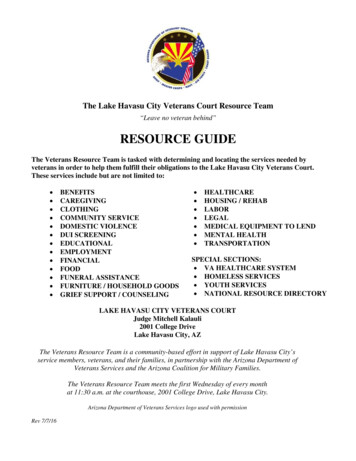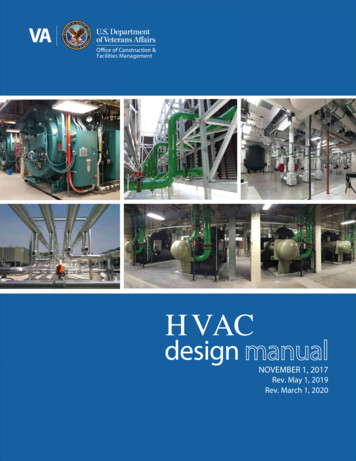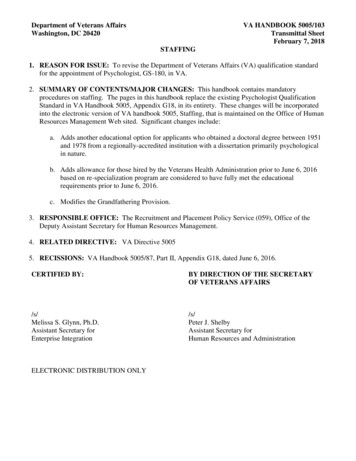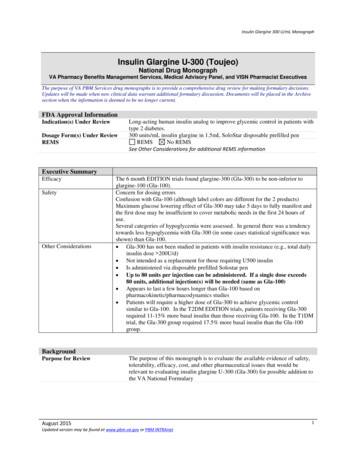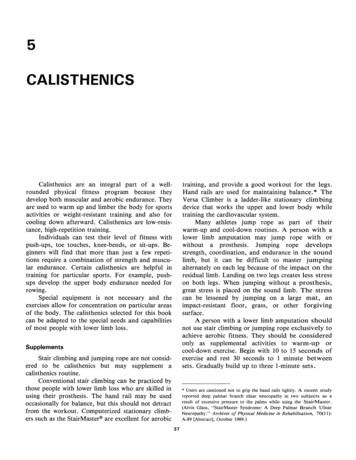
Transcription
5CALISTHENICSCalisthenics are an integral part of a wellrounded physical fitness program because theydevelop both muscular and aerobic endurance . Theyare used to warm up and limber the body for sportsactivities or weight-resistant training and also forcooling down afterward . Calisthenics are low-resistance, high-repetition training.Individuals can test their level of fitness withpush-ups, toe touches, knee-bends, or sit-ups . Beginners will find that more than just a few repetitions require a combination of strength and muscular endurance . Certain calisthenics are helpful intraining for particular sports . For example, pushups develop the upper body endurance needed forrowing.Special equipment is not necessary and theexercises allow for concentration on particular areasof the body . The calisthenics selected for this bookcan be adapted to the special needs and capabilitiesof most people with lower limb loss.training, and provide a good workout for the legs.Hand rails are used for maintaining balance .* TheVersa Climber is a ladder-like stationary climbingdevice that works the upper and lower body whiletraining the cardiovascular system.Many athletes jump rope as part of theirwarm-up and cool-down routines . A person with alower limb amputation may jump rope with orwithout a prosthesis . Jumping rope developsstrength, coordination, and endurance in the soundlimb, but it can be difficult to master jumpingalternately on each leg because of the impact on theresidual limb . Landing on two legs creates less stresson both legs . When jumping without a prosthesis,great stress is placed on the sound limb . The stresscan be lessened by jumping on a large mat, animpact-resistant floor, grass, or other forgivingsurface.A person with a lower limb amputation shouldnot use stair climbing or jumping rope exclusively toachieve aerobic fitness . They should be consideredonly as supplemental activities to warm-up orcool-down exercise . Begin with 10 to 15 seconds ofexercise and rest 30 seconds to 1 minute betweensets. Gradually build up to three 1-minute sets.SupplementsStair climbing and jumping rope are not considered to be calisthenics but may supplement acalisthenics routine.Conventional stair climbing can be practiced bythose people with lower limb loss who are skilled inusing their prosthesis . The hand rail may be usedoccasionally for balance, but this should not detractfrom the workout . Computerized stationary climbers such as the StairMaster are excellent for aerobic* Users are cautioned not to grip the hand rails tightly . A recent studyreported deep palmar branch ulnar neuropathy in two subjects as aresult of excessive pressure to the palms while using the StairMaster.(Alvin Glass, "StairMaster Syndrome : A Deep Palmar Branch UlnarNeuropathy ." Archives of Physical Medicine in Rehabilitation, 70(11):A-89 [Abstract], October 1989 .)37
38RnoaClinical Guide . Physical Fitness : A Guide for Individuals with Lower Limb LossStair climbingMany people go out of their way to avoidclimbing stairs ; however, with the advent of computerizedmachines that can vary resistance, this aerobic exercise isgaining popularity at many health clubs . Greg Manninoworks out against a high setting of resistance .This is a simple way to work the cardioJumping ropevascular system . A person wearing a prosthesis or jumpingwithout it should jump rope only in brief intervals as part of awarm-up or cool-down routine .
39Conditioning Exercises : General Warm-up/Cool-down1Jumping JacksNeck/Sternocleidomastold2Neck RollsNeck/Sternocleidomastoid3Free-Hand Neck ResistanceShoulder/Upper Body4Arm CirclesAbdomen/Upper Body5Alternating Toe Touch with BarWaist/Upper Body6Trunk TwistsAbductor/Outer Thigh7Abductor/Adductor Leg RaiseAbductor/Outer Thigh8Prone Leg ExtensionGastroc/Soleus9Standing One-Legged Toe RaiseOPTIONS : Jumping rope, stair climbing
40RRDS Clinical Guide . Physical Fitness : A Guide for Individuals with Lower Limb LossEXERCISE 1 . JUMPING JACKSPURPOSEWarm-up and/or cool-down exercise for the entire body.PROCEDURE Begin by standing with feet together and hands at sides.Simultaneously bring your hands together directly above your head, jump, and splitboth legs wider than shoulder-width, as shown in photo. Without stopping, jump both legs back together and bring arms down to the sides ofthe body. Gradually work up to at least 20 repetitions.MODIFICATIONSIf jumping on the residual limb causes pain, simply favor the sound side . A flexible AKbrim or a CAT/CAM or Narrow M/L Socket will provide stability and comfort . BK-levelindividuals who experience discomfort may require socket modifications.NOTEAlmost all the jumping and push-off isdone by the sound leg . The side with theprosthesis must keep pace ; move the legaway from the midline and back again towhere the heels are nearly touching in afluid motion.This exercise is uaedaswmnn-upund000down for the muscles of the upper and lower body .
41Conditioning Exercises : CalisthenicsEXERCISE 2 . NECK ROLLSPURPOSEStretches and exercises the neck muscles.PROCEDURE (CLOCKWISE ROTATION)nnnnnnBend the neck until the chin touches the chest.Roll the head to the right until the right ear touches the right shoulder.Roll the head back, bringing the chin up as far as possible.Roll the head to the left until the left ear touches the left shoulder.Repeat steps 1 through 4.Rest (20-30 seconds) ; then perform the exercise in two counter-clockwise rotations.Fifteen to 20 repetitions are recommended for each rotation sequence.MODIFICATIONSNone .This is a preliminary exercise . It may be done while standing or seated .
42RRDS Clinical Guide . Physical Fitness : A Guide for Individuals with Lower Limb LossEXERCISE 3 . FREE-HAND NECK RESISTANCEPURPOSEDevelops strength in the neck muscles . This exercise is often used as a warm-up forweightlifting exercise.PROCEDURE : FRONTN As shown in the photo, interlock fingers and place both hands against the forehead.Push the hands and head against each other.MI Start with the head back and push forward.PROCEDURE : BACKII Interlock fingers and place both hands on the back of the head . Again push the handsagainst the head. Start with the head forward and push backward.PROCEDURE : SIDESIM As shown in the photo, place the right palm against the right side of the head.MI Start with the head on the left shoulder and push it against the hand as the hand resists.Continue until the head is resting on the right shoulder. Do the same with the left hand on the left side of the head. Repeat the entire sequence (front to back to sides) 15 to 20 times.MODIFICATIONSNone.Samantha Ellis and Greg Mannino demonstrate frontresistance .Ellis and Mannino demonstrate side resistance .
43Conditioning Exercises : CalisthenicsEXERCISE 4 . ARM CIRCLESPURPOSEExercises the shoulders, arms, and the upper back.PROCEDURE Stand with the feet shoulder-width apart and arms full length at each side . Bring botharms to shoulder height, as shown, and move them in a small circular motion.MI Begin by circling forward for 15 to 20 repetitions, then circle the arms backward for 15to 20 repetitions.n Bring both arms down to the sides of the body and relax for about 10 seconds beforebeginning a second set of the exercise.II Vary the size of the circles from small to large and increase the speed . This will assist inlimbering the shoulders and upper back.MODIFICATIONThis exercise may be performed while either standing or sitting.Ellis and Mannino perform this exercise as a warm-up for the shoulders, upper back, and arms .
44RRDS Clinical Guide . Physical Fitness : A Guide for Individuals with Lower Limb LossEXERCISE 5 . ALTERNATING TOE TOUCHES WITH BARPURPOSEWarm-up and cool-down exercise for muscles of the upper body, shoulders, arms,abdominal muscles, and the hamstrings . The bar helps to keep the shoulders straight whileperforming this exercise.PROCEDUREII Place a bar (about 36 inches in length) on the shoulders and hold it on both ends asshown in the photo.n Bend from the waist, keeping the torso approximately parallel to the floor . (Try not tobend the knees .)14 Twist the body in a smooth motion so that the left hand touches the right foot, asshown . The right arm will be extended in the air.4 Raise to an upright position and repeat for the other side.4 Fifteen to 20 repetitions are recommended.al Suggested sequence:— Toe touch left hand to right foot.— Upright.— Toe touch right hand to left foot.— Upright.— Repeat the sequence 15 to 20 times.MODIFICATIONSThe anterior brim of an AK socket mayimpair one from touching the floor . Aflexible brim and Narrow M/L socket canhelp.This exercise may be carried out in thesitting position, which increases trunk stability and decreases back stress.CAUTIONStretch gradually, do not bounce . Bouncingmay stretch the muscles too far and possiblycause injury .Warm-up and cool-down exercise that helps develop muscle tone on the waistline and upper body,including increased flexibility of the back.
45Conditioning Exercises : CalisthenicsEXERCISE 6 . TRUNK TWISTSPURPOSEHelps develop muscle tone on the waistline and upper body, including increased flexibilityof the neck.PROCEDUREn Keep the feet planted on the floor and spaced a bit wider than the shoulders.n Raise both arms to chest height, keeping the elbows slightly bent.n Twist side to side from the waist, as shown in the photo . Try to rotate far enough sothat each shoulder reaches at least the midline of the body.n Twist on both sides 15 to 20 times.VARIATIONn Place a bar (about 36 inches in length) on the shoulders and hold it at both ends.n Keeping both feet on the floor with knees straight but relaxed keep hips still and twistfrom the waist to each side, as shown in the photo.MODIFICATIONThis exercise may be performed from a seated position.Ellis and Mannino twist from side to side in a rotary motion .CAUTIONStretch gradually, do not bounce . Bouncingmay stretch the muscles too far and possiblycause injury.Mannino demonstrates a variation using ashoulder bar .
46RRDS Clinical Guide . Physical Fitness : A Guide for Individuals with Lower Limb LossEXERCISE 7 . ABDUCTOR/ADDUCTOR LEG RAISEPURPOSEWorks the muscles of the inner thigh and outer thigh, which, when strengthened, improvebalance and control while walking and in other ambulatory activities.PROCEDURE 1 : ABDUCTORSII Lie on one side with one arm holding the head up and the other resting at the waist(beginners may use this arm as additional support by placing the palm of the hand onthe floor).n Keeping both legs straight, raise the top leg about 12 to 15 inches from the floor, asdemonstrated in the top and middle photos. Hold at the high position for a few seconds before lowering the leg.le Raise the leg up only high enough to maintain tension on the abductors, as seen in thephoto. Fifteen to 20 repetitions are recommended.NOTEIn the middle photo, Linda Pedersen demonstrates a wide range of motion to include a stretchin the exercise . However, the tension on the abductors is no longer effective at this height.PROCEDURE 2 : ADDUCTORSn Lift the bottom leg in front of the other leg, as shown in the photo . (You will not beable to raise it as high as you were able to raise the top leg .)n Hold the high position for a few seconds before lowering the leg.n Fifteen to 20 repetitions are recommended.MODIFICATIONManually lock the knee for AK prostheses .
47Conditioning Exercises : CalisthenicsMannino works the abductorthigh muscles.Pedersen strengthens the hip abductorswith a scissors-type stretch added tothe exercise .Mannino works the adductorthigh muscles .
48RRDS Clinical Guide . Physical Fitness : A Guide for Individuals with Lower Limb LossEXERCISE 8 . PRONE LEG EXTENSIONPURPOSEDevelops the hamstring and gluteal muscles.PROCEDUREn Lie on the floor in a prone position.n Alternate raising one leg at a time by extending from the hip . Keep both legs as straightas possible.n Bring each leg up as high as possible in order to gain the full benefit from the exercisebefore lowering the leg.n Work each leg separately doing 15 to 20 repetitions per set, then switch legs . No rest isnecessary between sets.VARIATIONHold the fully raised position for a few seconds, contracting the muscles of the hamstringand gluteus . Then lower the leg slowly to the floor.MODIFICATIONSThis exercise may be performed with or without the prosthesis . However, the prosthesisprovides more weight resistance, thus working the muscles harder.CAUTIONLow back hypertension against resistance cancause undue stress to the spine . Observe caution ; do not strain this area.Pedersen exercisesthe prosthetic side .
49Conditioning Exercises : CalisthenicsEXERCISE 9 . STANDING ONE-LEGGED TOE RAISEPURPOSEDevelops strength and definition in the gastrocnemius/soleus muscles.PROCEDUREn Stand with your feet close together . Hold onto a support with one or both hands. Raise up on your toes on the sound side as shown in the photo . Hold the position atthe top for a few seconds before lowering the heel. Perform this exercise in a slow, controlled motion. For full calf development use three positions:— Point toes straight ahead to work calfmuscle in general.Point toes inward to work outer calfspecifically.Point toes outward to work inner calfspecifically.- Fifteen to 20 repetitions are recommended.VARIATIONFor a greater range of motion, stand on araised step with your heel off the edge sothat it may be lowered further . The standing toe raise may also be done while usingbarbells.The toes are pointed inward, working the outer calf .
Calisthenics are an integral part of a well-rounded physical fitness program because they develop both muscular and aerobic endurance . They are used to warm up and limber the body for sports activities or weight-resistant training and also for cooling down afterward . Calisthenics are low-resis-tance, high-repetition training. Individuals can test their level of fitness with push-ups, toe .
